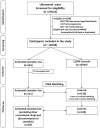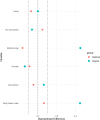Cannabis exposure during pregnancy and perinatal outcomes: A cohort study
- PMID: 38504476
- PMCID: PMC11103132
- DOI: 10.1111/aogs.14818
Cannabis exposure during pregnancy and perinatal outcomes: A cohort study
Abstract
Introduction: Cannabis potency and its use during pregnancy have increased in the last decade. The aim of this study was to investigate the impact of antenatal cannabis use on fetal growth, preterm birth and other perinatal outcomes.
Material and methods: A propensity score-matched analysis was performed in women with singleton pregnancies attending a tertiary care site in Barcelona. Women in the cannabis group were selected based on the results of a detection test. Primary outcomes were small for gestational age at birth (SGA), low birthweight and preterm birth. Secondary outcomes were other biometric parameters (neonatal length and head circumference), respiratory distress, admission to the neonatal intensive care unit and breastfeeding at discharge. A second propensity score-matched analysis excluding other confounders (use of other recreational drugs and discontinuation of cannabis use during pregnancy) was performed.
Results: Antenatal cannabis was associated with a higher odds ratio of SGA (OR 3.60, 95% CI: 1.68-7.69), low birthweight (OR 3.94, 95% CI: 2.17-7.13), preterm birth at 37 weeks (OR 2.07, 95% CI: 1.12-3.84) and 32 weeks of gestation (OR 4.13, 95% CI: 1.06-16.11), admission to the neonatal intensive care unit (OR 1.95, 95% CI: 1.03-3.71), respiratory distress (OR 2.77, 95% CI: 1.26-6.34), and lower breastfeeding rates at discharge (OR 0.10, 95% CI: 0.05-0.18). When excluding other confounders, no significant association between antenatal cannabis use and SGA was found.
Conclusions: Antenatal cannabis use increases the risk of SGA, low birthweight, preterm birth and other adverse perinatal outcomes. However, when isolating the impact of cannabis use by excluding women who use other recreational drugs and those who discontinue cannabis during pregnancy, no significant association between antenatal cannabis use and SGA birth was found.
Keywords: birthweight; cannabis; fetal growth; preterm birth; recreational drugs; small for gestational age.
© 2024 The Authors. Acta Obstetricia et Gynecologica Scandinavica published by John Wiley & Sons Ltd on behalf of Nordic Federation of Societies of Obstetrics and Gynecology (NFOG).
Conflict of interest statement
The authors declare no conflict of interests.
Figures
Similar articles
-
Cannabis Use in Pregnancy and Neonatal Outcomes: A Systematic Review and Meta-Analysis.Cannabis Cannabinoid Res. 2024 Apr;9(2):470-485. doi: 10.1089/can.2022.0262. Epub 2023 Feb 1. Cannabis Cannabinoid Res. 2024. PMID: 36730710 Free PMC article.
-
Association between IVF/ICSI treatment and preterm birth and major perinatal outcomes among dichorionic-diamnionic twin pregnancies: A seven-year retrospective cohort study.Acta Obstet Gynecol Scand. 2021 Jan;100(1):162-169. doi: 10.1111/aogs.13981. Epub 2020 Oct 5. Acta Obstet Gynecol Scand. 2021. PMID: 32865233
-
Maternal Cannabis Use Disorder and Neonatal Health Outcomes: A Data Linkage Study.BJOG. 2025 Mar;132(4):529-538. doi: 10.1111/1471-0528.18024. Epub 2024 Nov 25. BJOG. 2025. PMID: 39587322
-
The Effects of Cannabis Use during Pregnancy on Low Birth Weight and Preterm Birth: A Systematic Review and Meta-analysis.Am J Perinatol. 2024 Jan;41(1):17-30. doi: 10.1055/a-1911-3326. Epub 2022 Jul 28. Am J Perinatol. 2024. PMID: 35901851
-
The gestational weight gain and perinatal outcomes among underweight women with twin pregnancies: Propensity score matched analysis from a three-year retrospective cohort.Eur J Obstet Gynecol Reprod Biol. 2019 Dec;243:97-102. doi: 10.1016/j.ejogrb.2019.10.009. Epub 2019 Oct 21. Eur J Obstet Gynecol Reprod Biol. 2019. PMID: 31678762
References
-
- Lozano J, García‐Algar O, Marchei E, et al. Prevalence of gestational exposure to cannabis in a Mediterranean city by meconium analysis. Acta Paediatr. 2007;96:1734‐1737. - PubMed
-
- Arzimanoglou A, Brandl U, Cross JH, et al. Epilepsy and cannabidiol: a guide to treatment. Epileptic Disor. 2020;22:1‐14. - PubMed
-
- Singh S, Filion K, Abenhaim H, Eisenberg M. Prevalence and outcomes of prenatal recreational cannabis use in high‐income countries: a scoping review. BJOG. 2020;127:8‐16. - PubMed
MeSH terms
LinkOut - more resources
Full Text Sources




